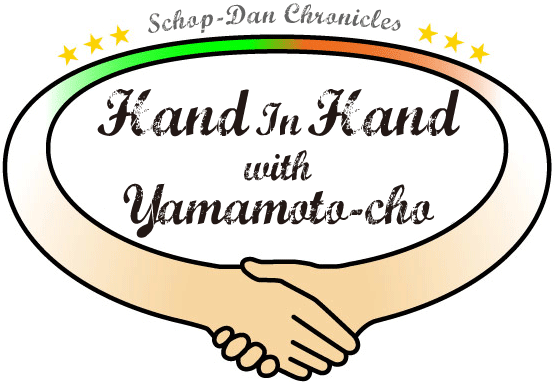Schop-Dan's next target was Joshoji, a Jodo-shu Buddist temple.


As expected, the tsunami had left its mark. The temple's gate posts were both knocked down. On the wall of the main hall, just below the clock was the “mud line” from the tsunami where the waves had reached.

According to the Chief Priest, it was more mud than water that filled the room. The doors hadn't even opened; he had to break the window just to enter the Main Hall.

Schop-Dan got to work tackling the clean-up of the Joshoji cemetery. Many gravestones were washed away and scattered all over the place. No one knew which stone belonged to which grave. Adding to the confusion, the family names on the stones were almost all the same. Larger gravestones were lying on the ground here and there, but the smaller stones for lighting incense sticks and small statues were buried under the mud.

As usual, Schop-Dan volunteers started without any instructions. Volunteers would spread out to wherever each wanted to start from and then planned the next steps on their own.

I decided to remove everything but the gravestones. I got to work pulling up the thick weeds and shoveling up the mud.
After digging for a while, I struck a huge pile of plastic sheets and strings, and wondered what they were for. The answer came with the next thing I salvaged: They were plastic package cases for strawberries, the ones you see in the supermarket.

Yamamoto-cho is well known for strawberries. Before the earthquake, there were many strawberry fields along the seashore. The strip of fields stretching from north to south was called Strawberry Road. It was almost entirely wiped out by the tsunami. The pile of plastic sheets must have been part of a plastic green house on one of the strawberry fields.
Next I pulled out broken lights. Other than the plastic sheets, I also found bowls, socks, woolen mittens, books, binders, a pair of jeans, a classic black phone, lots of wood chips (perhaps stupas from the cemetery), and even a string of potatoes. Probably a potato from someone's refrigerator had been brought here by the tsunami and then become the seed potato for an incongruous crop.
I froze at that point. I suddenly realized that nobody else had previously touched the ground where I was digging. It could be that I even discover a missing person or a dead animal. I proceeded to dig very carefully with my work gloves.
The summer weeds had tough roots which made the digging extremely difficult. I took the mud away with a dust pan and made progress little by little.


Remove everything but the stones. Dig out the gravestones. Put back the gravestone to where it belongs (as long as you can find where). Those were the objectives I focused on, and I just kept digging and digging with my work gloves.



During the breaks, I checked with my colleagues. "I just keep digging out the gravestones and organizing the place, but it’s very tough to remove the mud," was the standard response. We could hardly see light at the end of the tunnel. But bit by bit, the cemetery started to change.

At the end of the day the Chief Priest said: "I can only thank you. The locals who belong to this temple came out to see you all work. They saw the gravestones being put back and the passage being cleared. They said they felt courage coming back to them. It would be greatly appreciated if you could come again."
I thought I'd choke up from those words.
We gathered in a circle at the end. Ryo Taira, Schop-Dan team leader said, "Great work everyone. We'll come back to this temple next week."

It was only several hours that I spent here with these people but I felt I was able to connect with them and share the same feeling.



When you look, you can see many tsunami-stricken houses lined up from here to the distance.
Taira says, "We cannot change the entire world. But, we can change someone's situation like we did today. It's very simple. Just don't give up."

(To be continued)
|





















